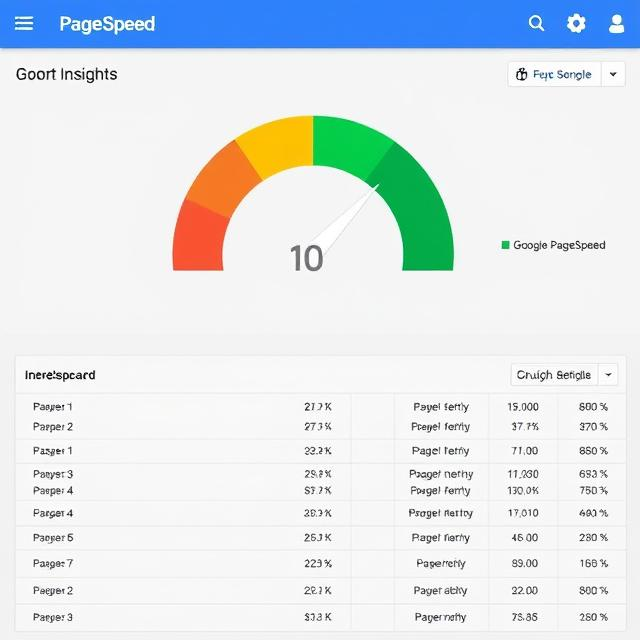In today’s fast-paced digital world, website performance is more crucial than ever. Whether you’re running an e-commerce site, a blog, or a portfolio, the speed at which your website loads can impact user experience, search engine rankings, and even your bottom line. Fortunately, one of the most effective tools available for diagnosing and improving website speed is Google PageSpeed Insights.
Google PageSpeed Insights is a free tool from Google that helps website owners, developers, and digital marketers analyze their website’s performance and identify areas for improvement. By providing in-depth insights and actionable recommendations, Google PageSpeed Insights empowers you to optimize your site, enhance user experience, and drive better results.
In this article, we’ll take a comprehensive look at Google PageSpeed Insights, how it works, and how you can use it to enhance your website’s performance. Whether you’re a beginner or an experienced web developer, this guide will help you understand how to leverage this powerful tool for maximum benefit.
What is Google PageSpeed Insights?
Google PageSpeed Insights is a tool developed by Google that evaluates the performance of a website on both mobile and desktop devices. It provides a score (ranging from 0 to 100) to indicate how well your website performs in terms of loading speed and usability. In addition to the performance score, Google PageSpeed Insights also offers detailed suggestions on how to optimize your website for faster loading times and better user experience.
The tool runs a series of tests to measure how quickly a page loads and how it performs on different devices. It then provides actionable insights to help you make the necessary improvements. These recommendations typically address areas like image optimization, server performance, code minification, and more.
Why is Website Speed Important?
Website speed is critical for several reasons. Let’s look at why optimizing your website with Google PageSpeed Insights is essential:
-
User Experience: Slow-loading websites create a frustrating experience for users. If your website takes too long to load, visitors are more likely to leave and visit a competitor’s site instead. In fact, studies show that 53% of mobile users abandon sites that take longer than 3 seconds to load.
-
SEO Ranking: Google considers website speed as a ranking factor in its search algorithm. Websites that load faster are more likely to rank higher in search engine results pages (SERPs). By using Google PageSpeed Insights to improve your website’s speed, you can boost your search engine rankings and attract more organic traffic.
-
Conversion Rates: Faster websites generally have higher conversion rates. Whether you’re running an online store or collecting leads through a contact form, faster page load times can increase your chances of converting visitors into customers or clients.
-
Mobile Optimization: With the increasing number of mobile users, optimizing your site for mobile devices is essential. Google PageSpeed Insights tests both desktop and mobile performance, ensuring your site loads quickly on all devices and screens.
-
Reduced Bounce Rates: A slow website can lead to high bounce rates, meaning visitors leave your site without interacting with it. High bounce rates can negatively impact your rankings and engagement, so using Google PageSpeed Insights to improve load times can help reduce bounce rates and improve user retention.
How Does Google PageSpeed Insights Work?
When you input your website URL into Google PageSpeed Insights, the tool analyzes various performance metrics and generates a score based on its findings. The score is split into two sections: one for mobile performance and one for desktop performance. Here’s an overview of how the tool works:
-
Performance Score: This score ranges from 0 to 100, with higher scores indicating better performance. A score of 90 or above is considered excellent, while a score below 50 means there is significant room for improvement.
-
Core Web Vitals: In addition to the performance score, Google PageSpeed Insights evaluates key metrics known as Core Web Vitals. These include:
- Largest Contentful Paint (LCP): Measures loading performance by tracking how long it takes for the largest visible element on the screen to load.
- First Input Delay (FID): Measures interactivity by tracking the time it takes for a user to be able to interact with the page (such as clicking a button or entering text).
- Cumulative Layout Shift (CLS): Measures visual stability by tracking unexpected layout shifts as the page loads.
-
Suggestions for Improvement: After generating the performance report, Google PageSpeed Insights provides a list of recommendations that can help improve your website’s performance. These may include actions like optimizing images, deferring non-critical JavaScript, and enabling compression.
-
Lab Data vs. Field Data: Google PageSpeed Insights uses both lab data and field data for its analysis. Lab data is collected in a controlled environment using simulated devices, while field data reflects real user experiences. The combination of both provides a more accurate picture of your website’s performance.
Key Metrics and Recommendations from Google PageSpeed Insights
Let’s take a look at some of the key metrics that Google PageSpeed Insights uses to evaluate website performance and the common recommendations it provides to improve these areas:
1. Image Optimization
One of the most common issues that Google PageSpeed Insights identifies is unoptimized images. Large image files can significantly slow down a website. Google PageSpeed Insights may recommend compressing images or using modern formats like WebP to reduce file sizes without compromising quality.
2. Minifying CSS, JavaScript, and HTML
Another common recommendation is to minify CSS, JavaScript, and HTML files. Minification involves removing unnecessary characters (such as spaces and comments) from the code to reduce file size and improve loading times. Google PageSpeed Insights often suggests minifying these files to speed up your website.
3. Leverage Browser Caching
Google PageSpeed Insights may recommend leveraging browser caching to improve performance. Browser caching allows your website’s static assets (such as images, stylesheets, and scripts) to be stored in a visitor’s browser, so they don’t have to be re-downloaded every time they visit your site.
4. Reduce Server Response Time
If your website’s server takes too long to respond to requests, Google PageSpeed Insights will suggest ways to optimize server performance. This could involve upgrading your hosting plan, optimizing your database, or reducing server-side processes.
5. Enable Text Compression
Enabling text compression is another recommendation from Google PageSpeed Insights. This involves compressing your website’s HTML, CSS, and JavaScript files using algorithms like Gzip or Brotli. Compressed files take up less bandwidth and load faster, which can improve your website’s overall performance.
6. Defer Non-Essential JavaScript
If your website is loading too much JavaScript upfront, Google PageSpeed Insights may recommend deferring non-essential JavaScript files. This means loading the critical JavaScript first and postponing less important scripts until after the main content has been loaded.
How to Use Google PageSpeed Insights to Improve Your Website
Now that we understand how Google PageSpeed Insights works and the types of recommendations it provides, let’s dive into how you can use this tool to optimize your website. Here are some steps to follow:
1. Run a Performance Test
The first step is to input your website’s URL into Google PageSpeed Insights and run a performance test. Once the test is complete, you’ll receive a performance score for both mobile and desktop versions of your site.
2. Analyze the Report
Review the performance report provided by Google PageSpeed Insights. Pay close attention to the Core Web Vitals and the list of suggested improvements. The report will provide specific details on what’s slowing down your site and how you can address these issues.
3. Prioritize Recommendations
While all recommendations are important, some will have a more significant impact on your site’s performance than others. Start by addressing the issues that will have the biggest impact, such as image optimization, server performance, and reducing JavaScript execution.
4. Make the Necessary Changes
Implement the recommended changes based on the Google PageSpeed Insights report. This may involve optimizing images, minifying code, enabling caching, or using a content delivery network (CDN) to speed up load times. If you’re unsure how to make these changes, consider consulting with a web developer or using a website optimization plugin.
5. Retest Your Website
After making the necessary changes, retest your website using Google PageSpeed Insights. You should see improvements in your performance score. If there are still areas for improvement, continue to refine your site until you reach an optimal score.
Conclusion
Website performance is crucial for user experience, SEO, and conversions. By using Google PageSpeed Insights, you can gain valuable insights into your website’s performance and identify areas for improvement. Whether you’re a small business owner, an e-commerce site manager, or a content creator, optimizing your website with Google PageSpeed Insights can have a profound impact on your digital success.
By following the recommendations provided by Google PageSpeed Insights, you can speed up your website, improve user satisfaction, boost your SEO rankings, and ultimately drive more traffic and conversions. So, start using Google PageSpeed Insights today and take the first step toward a faster, more efficient website.


